| 1 | The world’s longest viper |
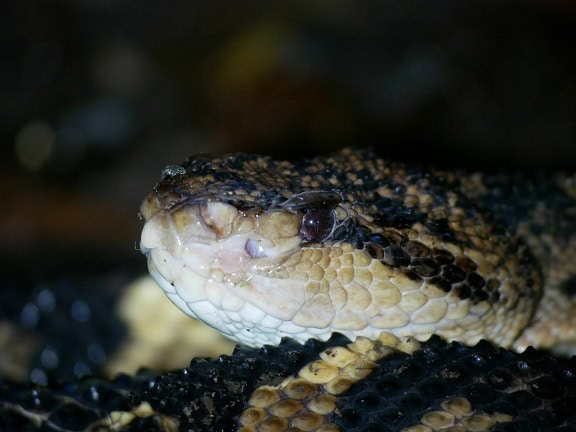
Worldwide, the mighty viper family (Viperadae) has over 300 members. The 50+ rattlesnake species are part of this family, as is the UK’s adder, and the green pitvipers of Thailand. But only one member can be the longest, and that honour falls to the South American bushmaster (Lachesis muta).
This is a jungle species which lives across a vast swathe of South America. To the north, South American bushmasters inhabit eastern Ecuador, Venezuela and Colombia. They then pass through the vast majority of Brazil, before reaching Bolivia and Peru to the south. They’re also found on the island of Trinidad.
South American bushmasters crawl out of their eggs at 30-50cm, and average at 2-2.5 metres long in adulthood. The longest South American bushmaster of all time measured 3.65 metres, excluding the craziest village rumours. This makes them the longest venomous snake in the western hemisphere, and the third longest worldwide, behind the black mamba (2nd) and king cobra (1st).
Being so massive, it can be a struggle for this snake to stay camouflaged, but South American bushmasters have a crafty solution: barely moving all day. This is a lazy ambush snake which lies motionless for days or even weeks in thick jungle foliage, waiting patiently for rodents (its main prey) to wander past.
| 2 | Blends perfectly with jungles |
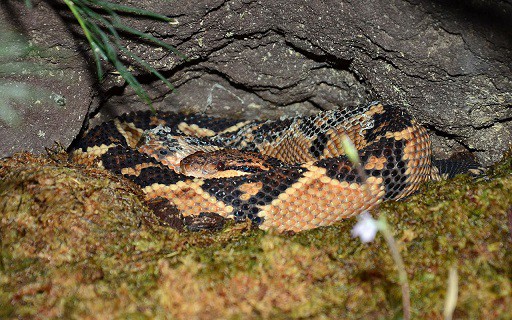
Compared to a boa constrictor, South American bushmasters have much narrower habitat requirements. You’ll never find them in town gardens, open grassland, or rocky hillside slopes. Instead, this species is a true ambassador of the jungle. They’re a creature of moist rainforests, covered with fallen leaves and green vegetation.
South American bushmasters require an average temperature of at least 24C, and rarely appear at above 1000 metres in altitude. Within jungles, they prefer upland areas rather than swampy riversides. The closest South American bushmasters come to humanity are villages adjacent to rainforests, but they’re also found in nearby farmland, particularly palm oil, sugar cane, banana and cacao plantations.
Compared to how widespread they are, South American bushmasters are rarely encountered by humans. Their brown-grey viper shades give them immense camouflage, and another reason is their tendency to lurk in shelter. They love to hide in the centres of hollow logs, and particularly in mammal burrows, including those of armadillos, pacas and agoutis. Unusually for a viper, newborns are even born underground, and sometimes don’t leave their burrows for several weeks or months.
| 3 | Huge venom totals |
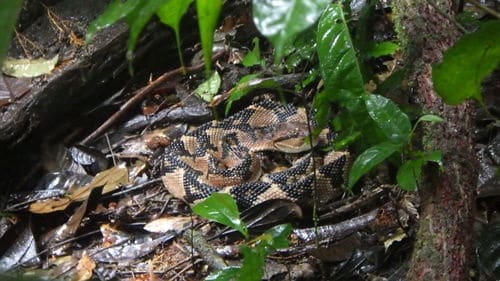
“So long are the fangs and so deep the wounds, that there is no hope of being cured“. Those were the words of explorer Sir Edward Sullivan back in 1852. Gram for gram, the bushmaster’s venom is only moderately deadly. Its LD50 toxicity score is 1.6-6.2mg in mice, compared to the African boomslang at 0.07mg, or the Saharan horned viper at 1.2mg.
Where the South American bushmaster beats the competition is in the massive quantity of venom it injects. The early estimate from the 1970s was 200-411mg per dry bite, but believe it or not, this was an underestimate. Later, more scientific estimates increased the venom yield to 500mg per bite, with the boomslang managing a pitiful 1.6-8mg.
Many snake venoms worldwide have deadly niches, like the neurotoxic tiger rattlesnake. But South American bushmasters cover almost the entire deadly spectrum: neurotoxic, necrotic, proteolytic, haemorrhagic and myotoxic (toxic to muscle tissue). It’s estimated that 1.4% of bites are fatal, and a high amount of deaths occur within 45 minutes. Time is short with this snake, but antivenom is widely available and has a high effectiveness. Typical symptoms include nausea, hypotension, sweating, diarrhoea, respiratory problems and impaired consciousness.
| 4 | Feared in folklore |
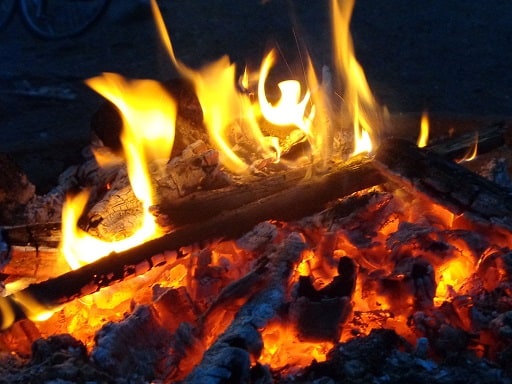
The South American bushmaster is a snake of endless superstitions, repeated by local tribes and villagers alike. Indigenous rainforest folk call it the “fire extinguisher” because of its unusual attraction to flames. They warn that lighting a fire in bushmaster country is practically suicide, as the usually lethargic snake will supposedly perk up and leap several metres through the air towards any flames it detects. There’s also tales of this snake stalking human beings for miles and even attacking passing motorbikes, after getting confused by the shining headlamps.
Some indigenous people dub this snake “shushupe”, believing it to be a shapeshifter which can transform into mammals. A classic legend speaks of a hunter pursuing a dying armadillo into its burrow, after inflicting a successful gunshot. The hunter pokes his arm in to retrieve his prize, but is instead greeted by the hissing face of a bushmaster. The pursued armadillo has switched back to its snake form, using its last available form of defence.
The real explanation of course, is that South American bushmasters regularly use armadillo holes as shelter. That said, nothing has been disproven…
| 5 | Mothers defend their eggs |
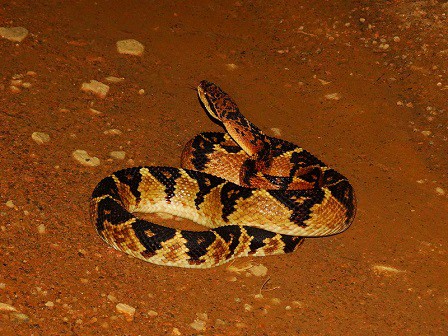
In the regions where they live, South American bushmasters contribute 4.5-7.5% of snake bites, possibly reaching 35% in the most bushmaster-heavy regions. But they also hold a friendlier record: being a rare snake to guard its freshly laid eggs.
Mother bushmasters lay 16-19 eggs at once, usually in an underground mammal burrow. As the babies develop, fueled by the nutritious yolk, the mother coils around her precious egg batch, frightening off predators by her menacing presence alone. While she stands watch, the mother bushmaster will barely eat. This caring nature was first spotted in 1910 by Bronx Zoo employee Raymond Ditmars (more on him soon). The moment the eggs hatch, the mother bushmaster slithers away, ready to seek new horizons.
South American bushmasters are born with a rare snake feature: a neon-orange, yellow or pinkish tail, which may be designed to confuse hungry predators. These Vegas-style colours fade by adulthood. Laying eggs itself is rare among vipers, most of which lay live young (including all rattlesnake species). In fact, the Lachesis bushmasters (4 members) are the only vipers in the entire western hemisphere to lay eggs.
| 6 | Lecky the celebrity bushmaster |
Raymond Ditmars was born in 1876, and eventually became one of the top herpetologists of the early 20th century. In his teenage years, he became particularly obsessed with the South American bushmaster, after unwisely ordering a crate of live snakes from Trinidad. An 8 foot bushmaster crawled out, and chased the teenage Ditmars all over his bedroom, until he finally deterred it with the hard whack of a broomstick.
It took Ditmars 4 decades to capture a live bushmaster, but on September 6th 1934, he finally fulfilled his life’s ambition on the island of Trinidad (although it was actually an assistant who made the capture). Newspaper headlines rang out, saying “Ditmars Obtains Live Bushmaster. Succeeds After 30-Year Hunt“. The bushmaster was quickly dubbed Lecky, the Mahatma Gandhi of reptiles.
Lecky was stored in a first class cabin en route to New York, and two weeks later, he was on proud display in Bronx zoo. 100,000 visitors arrived to gaze on him weekly, and Ditmars himself had to stop turning up, after being bombarded with visitor questions.
| 7 | How Lecky died |
Bushmasters fare notoriously badly in captivity, and it didn’t take long for Lecky to fall ill. Ditmars used every strategy to mimic Lecky’s natural habitat, like strewing leaf litter around the enclosure and keeping the humidity and temperatures to rainforest levels. But Lecky the bushmaster refused to eat, no matter how many dead rats were dangled in front of him.
Ditmars brought in Grace Olive Wiley, a middle aged snake charmer who picked up venomous snakes in her hands and whispered softly, claiming to have a special connection with them. The plan didn’t work. Finally, Ditmars used a pair of forceps to forcefeed Lecky, shoving a dead chicken into his mouth. This could have easily snapped Lecky’s spine, but “That chance seemed to be worth taking“, said Ditmars.
Lecky swallowed, and everyone breathe a sigh of relief. But 12 days later, on November 22nd 1934, Lecky was found dead in his enclosure. Medical analysis revealed parasitic worms hooked onto his heart, which he had ingested in his native Trinidad. Ditmars brought another bushmaster to Bronx zoo in 1935, this time called Cleopatra Arrima, which lasted significantly longer – nearly a whole year.
| 8 | Exceptionally long fangs |
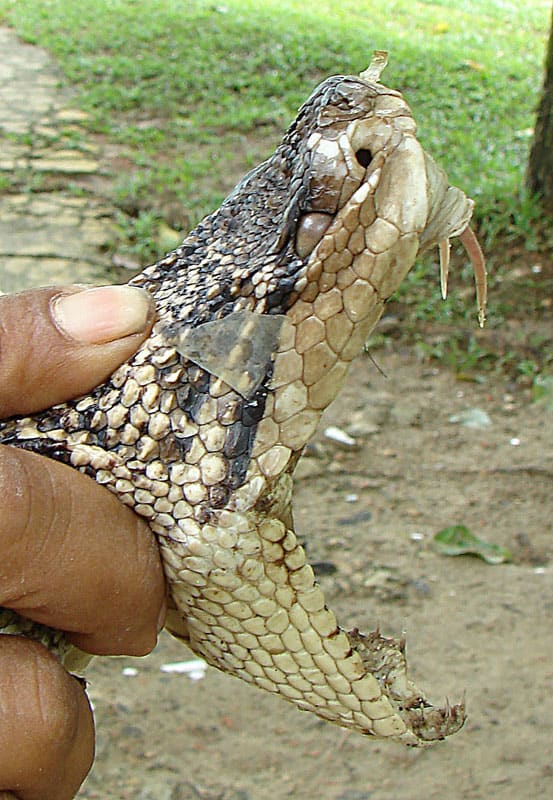
South American bushmasters don’t just have a jumbo length body. Their front fangs are viciously long, usually exceeding 2 inches (5cm), and just falling short of the African gaboon adder’s infamous 2.5 inch gnashers.
Fortunately, South American bushmasters have a relatively shy personality. They’ll attack humans if seriously flustered, but just as often flee into the undergrowth, while making a distinctive low whistling noise. Researchers have approached alert and awake bushmasters to within 40cm in the wild and triggered no aggressive response.
South American bushmasters can remain coiled in the same spot for 30 days, and survive on just 10 meals per year. Their diet is mostly rodents, with one favourite being the agouti, which has several species in South America and closely resembles a guinea pig. While some venomous snakes release their prey immediately after biting, South American bushmasters hold on tightly, keeping them in a prison of coils until they finally succumb.
Bushmasters also enjoy rice rats, spiny rats, squirrel rats, opossums and porcupines, occasionally venturing to small birds and frogs. Lachesis muta is capable of moving by day in extreme circumstances, but nearly 100% of their hunting takes place by night. Dusk is an easier time to spot them than dawn.
| 9 | More myths (possibly true) |
| 10 | A snake of many names |
South American bushmasters aren’t just surrounded by folklore, but have numerous nicknames with interesting origin stories. the bushmaster title was already being used in 1852, as shown by this quote from Sir Edward Sullivan: “The Couni Couchi or Bushmaster is the most dreaded of all the South America serpents; and, as his name implies, he roams absolutely master of the forest“.
As for the Latin name, Lachesis is one of the three fates in Greek mythology, or Moirai, the three sisters who cut the thread of life and assign all people and gods their destiny. Lachesis was the sister in control of lifespan, and there’s no doubt that the bushmaster can affect your lifespan.
Muta, meanwhile, translates to mute, and references the bushmaster’s similar (though far larger) appearance to rattlesnakes. The bushmaster swings its tail in the same style, but produces no rattle, just a sharp rustling sound against the jungle undergrowth below. Local names include shushúpe in Peru, pucarara in northern Bolivia, and makasneki in Suriname. The Peruvian name of verrugosa references its warty-looking scales.
| 11 | Only two subspecies |
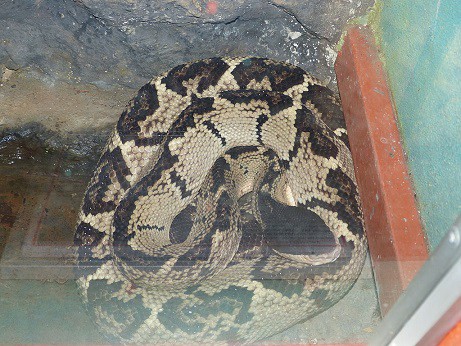
Once upon a time, the South American bushmaster had an even more colossal empire than it does today. Its subspecies included the rare-black-headed bushmaster in Costa Rica, and the more widespread Central American bushmasters further north. These versions have additional dark scales, including the namesake black head, and climb to 1600 metres in altitude instead of just 1000 metres.
Since 2010 however, DNA analysis has revealed these cousins to be independent species. The black-headed bushmaster became Lachesis melanocephala, while the Central American bushmaster became Lachesis stenophrys.
Meanwhile, the South American bushmaster was left with only two official subspecies. The first is simply Lachesis muta muta, the main one inhabiting a giant swathe of Amazon rainforest. The second version is the Atlantic forest bushmaster (L. muta rhombeata), which dwells solely in the coastal forests of southeast Brazil, including in southern Rio Grande and Rio de Jainero. This is separated from the Amazon subspecies by hundreds of miles, and may itself become an independent species one day.
| 12 | The Lachesis bushmaster crew |
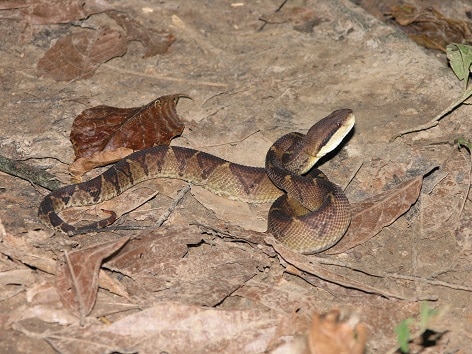
As of 2023, the bushmaster family stands at four species:
South American bushmaster – divided into two species as mentioned above.
Central American bushmaster (Lachesis stenophrys) – the second most common, ranging from Panama to southern Nicaragua.
Black-headed bushmaster (Lachesis melanocephala) – the least common, inhabits southern Costa Rica exclusively.
Chocoan bushmaster (Lachesis acrochorda) – inhabits western Ecuador, western Colombia, and eastern Panama.
Hard-working scientists have gradually narrowed down the timescales for these species. Despite looking similar, it turns out that the two Central American species split from the two South American species 6.5-18 million years ago. Even the black-headed bushmaster and Central American split an estimated 4-11 million years ago. Both are found in Costa Rica, but don’t overlap, being firmly separated by the towering Cordillera de Talamanca mountain range (max altitude 3820 metres).
Meanwhile, the Chocoan bushmaster is separated from the South American bushmaster by the Andes mountains. Originally, it was separated from central American bushmasters by rising sea levels and open ocean, which cut off South America. 3.5 million years ago, the Panama land bridge reformed, and the Chocoan and Central American bushmasters were reunited, but were now too genetically distinct to interbreed, and remained as separate species forever.
As for the two South American bushmaster species, the Atlantic forest version (eastern Brazil) split far more recently: just 300,000-800,000 years ago. In the Pleistocene, conditions were far cooler, creating swathes of forest habitat they could use as a corridor to the Atlantic. As the climate warmed, these were cut off, remaining stuck in a separate eastern colony.

Hi….how does it make that whistling sound?
Most likely a form of modified trachea. The king cobra is able to make a deep growling sound and scientists found that its trachea was lined with multiple small pouches which altered sound waves.